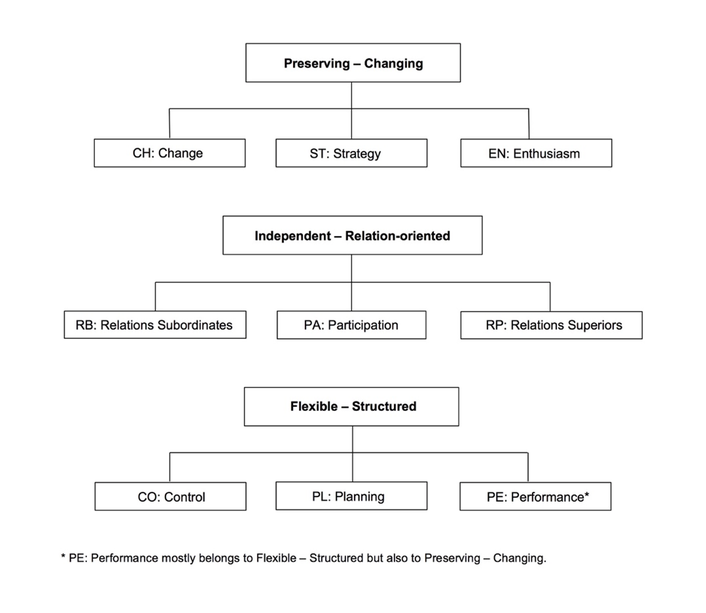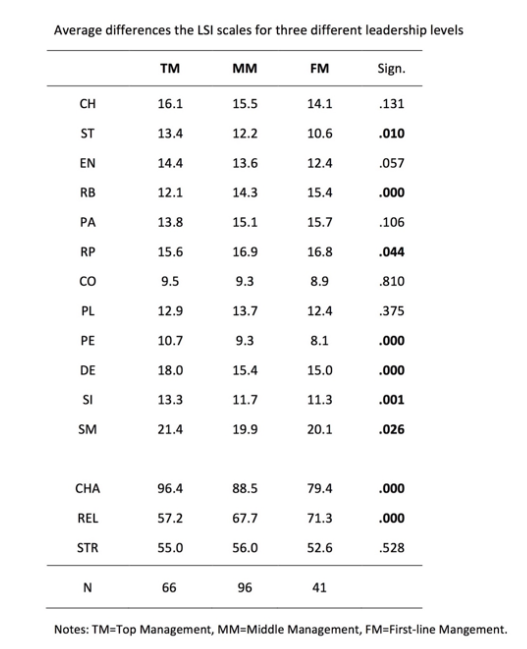During the autumn, Psytest will publish a number of survey results about leadership. The surveys are presented in more detail in a dissertation by Stefan Lindstam (see amazon.de, “The FSI Führungsstilinventar und das integrative Führungsmodell”, 2015). The dissertation is written in German, although it is based on Swedish surveys. In order to give readers easier access to these results, this article series consists of shortened and simplified presentations of selected survey results in English. The surveys are made by using the LSI Leadership Style Inventory Test. The underlying leadership style model is broad and general (compare the Big Five model within the personality field) and the conclusions are therefore generally relevant to people working in the field of management recruitment and leadership development.
The purpose of this analysis is to look at the differences in leadership style between managers at different levels, in this case, three levels: first-line managers (41 persons), mid-level managers (96 persons) and top-level managers (66 persons). First-line management consists of managers such as department managers and sales managers. In the public sector, corresponding titles are area manager and section manager. Middle-level management consists of, for example, functional managers, factory managers, site managers, and production managers. In the public sector, corresponding titles are department manager and unit manager. Top-level management consists of CEOs and other directors. In the public sector, corresponding titles are municipal chief executive and director of administration.
A brief description of the LSI test
The LSI test provides scores on three broad leadership style dimensions: Preserving vs. Changing, Independent vs. Relation-oriented and Flexible vs. Structured. These dimensions each represent a floating scale between two extremes and each extreme is considered a special leadership style, such as a Preserving Leadership Style or a Changing Leadership Style.
Each leadership style dimension has three sub-scales (so-called “style scales”). The sub-scales for the leadership style dimension Preserving–Changing are called CH: Change, ST: Strategy and EN: Enthusiasm. The leadership style dimension Independent–Relation-oriented has the sub-scales RB: Relations Subordinates, PA: Participation and RP: Relations Superiors. The leadership style dimension Flexible – Structured has the sub-scales CO: Control, PL: Planning and PE: Performance (PE: Performance is also linked to a Changing Leadership Style). In addition to the scales specified so far, the test also provides scores on three so-called “additional scales.” These are BE: Decisiveness, SI: Social Impact and SM: Stress Management. Together, these three scales more generally refer to the motivation and self-confidence of leadership.
In addition to the scales specified so far, the test also provides scores on three so-called “additional scales.” These are BE: Decisiveness, SI: Social Impact and SM: Stress Management. Together, these three scales more generally refer to the motivation and self-confidence of leadership.
Result

Regarding the three broad leadership style dimensions, the three groups differ because the higher the managerial level, the higher the average of the Change Dimension (CHA). The difference is highly significant and has also been shown previously in an independent survey. The results thus show that the higher the managerial level, the more change-oriented the leadership. This result was also expected since a top manager’s areas of responsibility are broader and usually require looking at a business from a cross-functional perspective. They also have a longer planning horizon and contribute to strategic discussions in the management team. First-line managers usually have a more operational focus.
The additional scales also distinguish between the groups in such a way that top managers get significantly higher values than mid-level managers and first-line managers, as was also expected, as motivation and confidence in leadership, on average, can be expected to grow with increasing management responsibility.
Less obvious is another difference between the managerial levels, which is also significant in two separate studies. It turns out that the higher the managerial level, the lower the Relationship dimension. That is, top managers describe themselves as having a more Independent leadership style. The top managers thus describe a leadership style that is characterized by a greater (professional) distance to employees, a stronger focus on the facts and a more independent and determined attitude about various issues. In first-line managers, however, one finds more focus on the relationships with both superiors and employees, helping and supporting employees who have problems, and establishing warm relationships.
If we look more closely at the Style and Additional Scales, top managers score significantly lower on RB: Relations Subordinates and RP: Relations Superiors. They score significantly higher on PE: Performance, DE: Decisiveness, SI: Social Impact, ST: Strategy and SM: Stress Management. For RP and SM, the tendency is not continuous. In a previous survey with only the categories “top managers” and “first-line managers,” the same scales significantly differentiated these groups. In addition, strategic thinking increases at higher management levels, so a more demanding (PE: Performance) and “tougher” leadership style (low RB and RP) seems to emerge.
One might conclude that top managers need different “social skills” than first-line managers. While first-line managers demonstrate leadership that is similar to common definitions of employee-oriented leadership (the manager gives attention, consideration and support to employees), it seems that top managers exhibit behaviors such as standing up for their opinions, thinking independently, adapting less to others and focusing more on the task and making demands on others. Thus, a “tougher” relationship management is shown, with emphasis on independence, setting requirements, and conflict-tolerance.
It can also be noted that there are no significant differences among the three groups in the Structural dimension (seen more in detail, it applies to the most central sub-scales CO: Control and PL: Planning).
Conclusions about recruitment and development of managers
The results suggest that while a more classical employee-oriented leadership can be developed in first-line managers, those who take further steps upward need to be prepared to keep others responsible for defined outcomes and to develop and defend their own ideas and opinions. In addition (of course), they need training to take a broader, more strategic perspective, to learn analysis models, to gather relevant information, to think more creatively, to develop more change-orientation, etc.
In terms of recruitment, this survey shows that top managers tend to be in the Changing and Independent direction (at least they do not usually get very high scores on the Relationship dimension) as well as on the Additional Scales. However, there is some influence from a manager’s function, which is listed in the section “Differences in Leadership Style for Different Functions.” The next article will first deal with leadership by restructuring.
